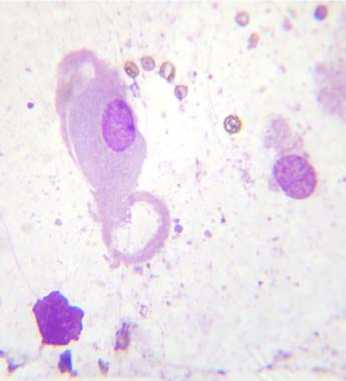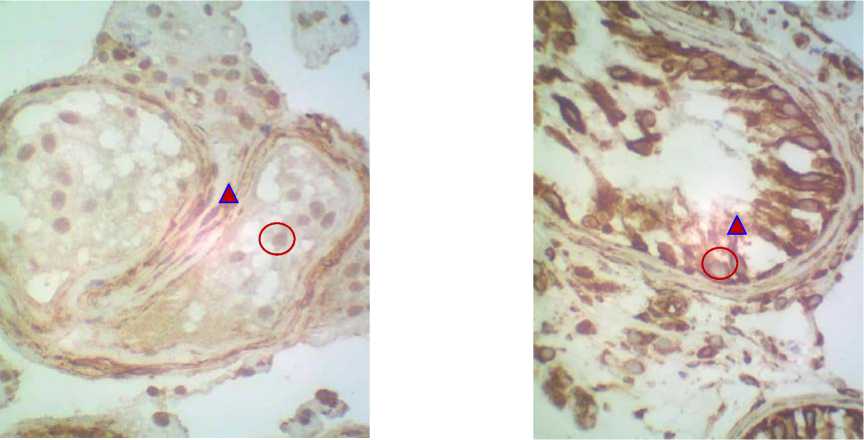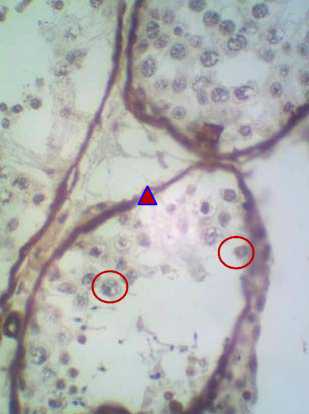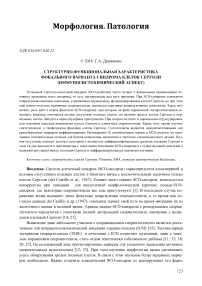Структурно-функциональная характеристика фокального варианта синдрома клеток Сертоли (иммуногистохимический аспект)
Автор: Демяшкин Григорий Александрович
Журнал: Вестник медицинского института "РЕАВИЗ": реабилитация, врач и здоровье @vestnik-reaviz
Рубрика: Морфология. Патология
Статья в выпуске: 1 (21), 2016 года.
Бесплатный доступ
Тотальный Сертоли-клеточный синдром (SCO-syndrome) часто путают с фокальными проявлениями основных признаков этого синдрома, то есть маскирующие под него признаки. При SCO-синдроме отмечается повреждения семенных канальцев, угрожающие нормальному функционированию клеток Сертоли, но при этом ещё можно получить единичные сперматозоиды, используя передовые репродуктивные технологии. Здесь, возможно, речь идёт о новом фенотипе SCO-синдроме, при котором на фоне нормальной гистархитектоники семенного канальца отмечается полное отсутствие половых клеток, но наличие зрелых клеток Сертоли и нормальных клеток Лейдига в перитубулярном пространстве. При втором подтипе: в нормальном структурированном семенном канальце выявляются клетки Сертоли и единичные сперматогонии. Кроме того, важно изучить синтетическую и трофическую функцию клеток Сертоли. Сустентоциты являются иммунонегативными для препубертатных маркеров дифференцировки: Цитокератин-18, антимюллеров гормон и М2А-антиген, но показывают положительное мечение для белков коннексина, виментина и частично гладкомышечного актина. Полное отсутствие половых клеток в сочетании с полностью дифференцированными зрелыми клетками Сертоли в этом случае находится в противоречии с известными подтипами SCO-синдрома и с существующей гипотезой о взаимной регуляции между клетками Сертоли и дифференцирующихся половыми клетками.
Сперматогенез, клетки сертоли, мужское идиопатическое бесплодие
Короткий адрес: https://sciup.org/14344168
IDR: 14344168 | УДК: 616.697-036.22
Текст научной статьи Структурно-функциональная характеристика фокального варианта синдрома клеток Сертоли (иммуногистохимический аспект)
Введение. Сертоли-клеточный синдром (SCO-синдром) характеризуется азооспермией и полным отсутствием половых клеток в биоптате яичка с исключительным наличием только клеток Сертоли (del Castillo et al. , 1947). Однако часто термин SCO-синдром, используется некорректно при описании для аналогичной морфологической картины: псевдо-SCO-синдром, где некоторые сперматозоиды все еще присутствуют [1]. В последнем случае поражение яичка вызывает лишь фокусные повреждения сперматогенеза, в то время как согласно данным del Castillo и др. (1947), гоноциты теряют свой путь во время миграции их из желточного мешка в половой валик. Ареалы псевдо-SCO-синдрома с резидуальным сперматогенезом чередуются с участками полной деструкцией сперматогенеза, связанные с незрелыми клетками Сертоли [14; 21].
Выявление даже небольших участков с сохранившимся сперматогенезом является достаточным для интрацитоплазматической инъекции сперматозоидов (ICSI) [15]. Тестикулярная экстракция сперматозоидов (TESE) в сочетании с ICSI позволяет мужчинам, даже с тяжелым поражением сперматогенеза, стать отцом генетически собственного ребенка [11; 13; 18; 20; 27]. На сегодняшний день прогнозирующие маркеры для успешного выявления активных сперматозоидов недостаточны [12; 25]. При этом изучение морфологии яичка увеличивает успех обнаружения зрелых половых клеток. В связи с этим изучение более надежных маркеров необходимо. Важно отличить классический SCO-синдром от маскирующих его форм.
Для этого важно изучить морфологию клеток Сертоли, используя современные методы гистологии, например, иммуногистохимию. Принимая во внимание светооптическую характеристику строения сустентоцитов, а также данные электронной микроскопии, можно сказать, что наиболее информативными маркерами для этих клеток являются белки элементов цитоскелета и межклеточных коммуникаций.
Виментин (Vimentin) MCV – аббревиатура для Mutated Citrullinated Vimentin (модифицированный цитрулинированный виментин) – белок массой 57–60 кДа является одним из пяти основных промежуточных филаментов в клетке . Данный элемент цитоскелета (филаменты) считается специфичным маркёром для саркомы и других мезенхимальных новообразований [26]. Последние данные указывают на наличие экспрессии виментина во многих типах карцином [26].
В тканях яичка виментин может использоваться для идентификации сустентоцитов [1]. Отдельные литературные источники указывают экспрессию виментина не только клетками Сертоли, но и в перитубулярных миоидных клетках и интерстициальных эндокриноцитах, в связи с чем, совместно с морфометрическими данными может служить маркёром азоспермии – синдрома клеток Сертоли [1].
SMA (Smooth muscle actin, гладкомышечный актин). Этот белок является маркёром гладкомышечных клеток и клеток, содержащих α-актин (например, в фибробластах) [4].
В яичке SMA экспрессирует в перитубулярных миоидных клетках вокруг извитых семенных канальцев, а также в гладких миоцитах кровеносных сосудов [16].
Материалы и методы . В качестве материала для исследования в работе использовали ткани яичек здоровых (контрольная группа) мужчин и биопсийный материал у лиц с патологией – идиопатическое бесплодие (клинически обоснованное).
Работа выполнена в трёх группах, учитывая уровень тестостерона (по Г.Г. Автандилову): I. – 100 мужчин первого периода зрелого возраста (22–35 лет) с нормальным сперматогенезом; II. – 100 мужчин пожилого возраста (61–74 года); III. – 100 мужчин первого периода зрелого возраста (22–35 лет) с идиопатическим бесплодием.
Объект исследования: во всех группах – правые семенники (яички) – биоптаты.
Иммуногистохимия (ИГХ). Количество срезов на каждом стекле - по два. После депарафинизации и повторной гидратации парафиновых срезов, IHC проводили для следующих антигенов.
Для окрашивания виментином (Vimentin) и гладкомышечным актином (SMA) срезы подвергали воздействию 20 % уксусной кислоты в течение 15 с., блокировали 5 % бовиналь-ной сывороткой (BSA) в течение 30 мин и инкубировали с моноклональными анти-Vimentin и анти-SMA первичными антителами (1: 100; DAKO, Гамбург, Германия) в течение часа. Срезы затем подвергают воздействию второго антитела (анти-кроличьего IgG, 1: 100; DAKO). После аппликации каждого реактива стекла со срезами отмывали в 0,1 М растворе фосфатного буфера в сосуде с мешалкой. Для визуализации реакции добавляли на каждый срез 1–3 капли DAB-хромогена. Инкубировали от 30 секунд до 20 минут под контролем в микроскопе. Ядра клеток докрашивали гематоксилином и срезы заключали в «Aquatex».
Оценка иммуногистохимических реакций базировалась на интенсивности окрашивания и разделении иммунопозитивных (положительных) клеток согласно рекомендациям 124
D . J. Dabbs « Diagnostic immunohistochemistry (2006 г.) » . Шкала интенсивности окрашивания: «–» – нет экспрессии (в ≤ 1 % клетках в срезе); «+» – слабая экспрессия (в 1–10 % клетках в срезе); «++» – умеренная экспрессия (в 10–50 % клетках в срезе); «+++» – интенсивное окрашивание (в ≥ 50 % клетках в срезе).
Для идентификации и дифференциации мужских половых клеток и клеток Сертоли в извитых семенных канальцах использовали метод отпечатков (рис. 1).

Рис. 1. Яичко. Отпечаток, по G.Giemsa, ×400. В центре – клетка Сертоли
Клиническое обоснование. Все исследуемые пациенты являются молодыми людьми в возрасте 22–35-ти лет. Они исследованы и соматически здоровы; 40 человек из 100 обследуемых спортивного телосложения, без вредных привычек. Из анамнеза заболевания следует, что у них после 2-х лет бездетности была обнаружена азооспермия (после длительного центрифугирования с положительной фруктозной и α-гликозидазой реакцией). Инфекционный анамнез не отягощён: соматических заболеваний, отягощающих сперматогенез, нет (например, эпидемический паротит) или врожденных аномалии не присутствовали. Обследованные молодые люди имеют нормальное сексуальное либидо и были сексуально очень активны.
Физическое обследование. Физическая экспертиза показала: оволосение на лобке по мужскому типу; мужской голос взрослого; высота 175–182 см и вес 68–84 кг. Локальное исследование: оба яичка в мошонке, обычных размеров (средний объем: справа – 18 мл, слева – 20 мл), мягкие по консистенции и безболезненные; варикоцеле не обнаружено; семейный анамнез по поводу варикозного расширения вен не отягощён.
Лабораторные данные (средние показатели) : сыворотка ФСГ – 9,8 МЕ/л (N: 5–15 МЕ/л), ЛГ – 5,5 МЕ/л (N: 1–9 МЕ/л), β-ингибин – 150 пг/мл (N: 100–400 пг/мл), тестостерон – 20 мг/26 нмоль/л (N: 10–20/12–33 нмоль/л); кариотип: 46, ХY, Y-микроделеции отсутствуют. Спермограмма: 5 мужчин – аспермия; 12 мужчин – олигозооспермия; 72 мужчины – азооспермия; 8 мужчин – криптозооспермия; 2 мужчин – астенозооспермия; 1 мужчина – терато-зооспермия.
Результаты . Гистология. На уровне биопсии, яички при идиопатическом бесплодии демонстрируют свойства классического и неклассического вариантов SCO-синдрома с полным или частичным отсутствием половых клеток в семенных канальцах. Клетки Сертоли представлены зрелыми формами, прикреплены к базальной мембране, образуя тубулярные полости, и содержат хорошо выраженное ядро с четко видимым ядрышком (рис. 2).
При наличии в извитых семенных канальцах единичных локусов сперматогоний целесообразно говорить о фокальном варианте SCO-синдрома.
Иммуногистохимия. Во всех группах (I-я, II-я и III-я): нити белка промежуточных филаментов виментина, который, как известно, присутствует во всех состояниях дифференцирующихся клеток Сертоли, показали положительное мечение в цитоплазме этих клеток, расположенных в семенных канальцах, которые идентифицированы как клетки Сертоли. Уровень экспрессии маркёра Vimentin высокой степени отмечается во всех зрелых клетках Сертоли («+++») и средней степени в некоторых (около 20 % от общего числа) незрелых клетках («+»). Уровень экспрессии Vimentin в половых клетках – 0 %. (рис. 3). Белок SMA во всех исследуемых группах (I-я, II-я и III-я): слабая экспрессия отмечается в единичных спермато-гониях («–±»). В клетках Сертоли визуализируется слабое накопление маркера («±»). В других видах половых клеток, в клетках Лейдига, а также в перитубулярных клетках экспрессии SMA не обнаружено («–»). Хорошо выражена экспрессия SMA в миоидных клетках стенки семенных канальцев, образуя выраженный коричневый овод («+++»). Уровень экспрессии SMA в половых клетках – 5 % (рис. 4).

Рис. 2. Яичко, извитой семенной каналец при идиопатическом бесплодии (мужчина 22–35 лет); ИГХ с антителами к SMA, окрашивание ядер гематоксилином, ×200. Δ – миоидные клетки, О – сперматогония
Рис. 3. Яичко, извитой семенной каналец при идиопатическом бесплодии (мужчина 22–35 лет); ИГХ с антителами к Vimentin, окрашивание ядер гематоксилином, ×200. Клетка Сертоли: Δ – цитоплазма, О – ядро

Рис. 4. Яичко, извитой семенной каналец при нормальном сперматогенезе (мужчина 22–35 лет); ИГХ с антителами к SMA, окрашивание ядер гематоксилином, ×200. Δ – миоидные клетки, О – половые клетки
Обсуждение . Для клинициста имеет ключевое значение разделение на группы пациентов с идиопатическим бесплодием: в одну входят пациенты с тотальным SCO-синдромом, в другую – с фокальным вариантом SCO-синдромом. В первом случае шансы оплодотворения снижены до нуля, что не скажешь про второй случай, при котором проявляются мелкие очаги, по крайней мере, качественного сперматогенеза. При фокальном варианте SCO-синдроме резко возрастает вероятность зачатия через ICSI.
Разделение SCO-синдрома на два варианта целесообразно по ряду позиций: для корректного описания морфологической картины, а также при выборе тактики дальнейшего лечения таких мужчин. Несмотря на то, что при фокальном варианте в базальном отсеке извитого семенного канальца присутствуют лишь сперматогонии, необходимо продолжать дальнейшие изучение пролиферативной и апоптотичекой активности сохранившихся половых клеток.
По del Castillo и др. (1947) SCO-синдром характеризуется: а) полное отсутствие половых клеток в семенных канальцах; б) нормальные клетки Сертоли с обильной цитоплазмой; в) отсутствие гистологической дегенерации ткани яичка; г) снижение объёма яичек.
Морфологический анализ семенного канальца при бесплодии позволяет различать следующие типы клеток Сертоли: I – нормальные взрослые клетки с выраженным плотным крупным ядром, грубо треугольной формы с тремя ядрышками; II – незрелые клетки с круглыми, часто расположенными ядрами; III – дисгенетические клетки, похожие на незрелые спермато-гонии-А, с почти зрелой цитоплазмой и с менее развитыми органеллами; IV – инволюциони-рующие клетки, с редко расположенными ядрами и зрелой цитоплазмой, содержащей в изобилии липидные капли, остаточные органеллы и атипичные межклеточные коммуникации.
Выявление виментина в клетках Сертоли напрямую зависит от фаз созревания и дифференциации самой клетки. В то время как виментин постоянно присутствует в клетках Сертоли, то по литературным данным антигены Цитокератин-18, антимюллеров гормон и М2А-антиген не выявляются: от препубертата к половому созреванию и зрелости. Выраженная экспрессия вимен-тина свидетельствует о зрелых формах клетках Сертоли в семенном канальце [2; 6; 7].
Белки цитоскелета SMA и виментин демонстрирует положительную экспрессию во всех группах. Наличие F-актина в миоидных клетках перитубулярных участках яичка дополняет до сих пор имеющиеся данные о наличии этого белка у других млекопитающих, например, в бычьих или овечьих семенниках [21; 23]. При этом следует учитывать о роли элементов цитоскелета в формировании гемато-тестикулярного барьера. Тем не менее, полученные результаты показывают, что начало экспрессии SMA в миоидных клетках, само по себе является маркёром гладкомышечной дифференцировки. Таким образом, выявление SMA можно считать маркёром нормального полового развития гонад, которые могли бы быть использованы в качестве параметра обследования мужчин (мальчиков) на разных этапах развития яичек.
Так как миоидные клетки находятся в тесном взаимодействии с клетками Сертоли [9, 10], то это является крайне важным для структурного формирования гемато-тестикулярного барьера. Перитубулярные миоидные клетки, как известно, стимулируют синтез клетками Сертоли андроген-связывающего белка и трансферрина. Они продуцируют белок под названием P-мод-S, который, как было показано, является важным регулятором функции клеток Сертоли in vitro [8], и они также считаются весьма влиятельными в модуляции эффектов андрогенов на извитые семенные канальца, и, следовательно, на сам сперматогенез [16].
Клетки Сертоли являются стабильными неделящимися клетками. При нормальном сперматогенезе при световой микроскопии сустентоциты маскируются за большим количеством половых клеток; при бесплодии (SCO-синдроме) же, напротив, половые клетки отсутствуют и поэтому хорошо визуализируются только лишь клетки Сертоли. Поэтому часто употребляемый термин при микроскопическом описании мужского бесплодия «гиперплазия клеток Сертоли» является не корректным.
Формирование гемато-тестикулярного барьера является необходимой вехой в развитии яичек, это происходит во время второго или третьего года жизни. То есть наличие SMA говорит о завершении формирования структур гемато-тестикулярного барьера.
Наличие виментина в пресперматогониях даёт нам аналогичную информацию. Ранее сообщалось, что виментин использовался в качестве маркера пресперматогоний в овечьих семенниках [19; 24]. Мы в своём исследовании также отмечаем этот факт и дополняем тем, что содержание этого белка заметно снижается по мере прогрессирования сперматогенеза.
Вывод. Таким образом, степень экспрессии виментина и SMA коррелирует со стадией развития: стадия заселения семенного канальца половыми клетками. Это может обеспечить альтернативу оценке возраста, массы тела и длины тела в будущих анализах, направленных на выявление возможных негативных последствий радиоактивного поражения сперматогенеза.
Белок виментин можно использовать в качестве дополнительного дифференциального маркера для определения степени зрелости клеток Сертоли при фокальном SCO-синдроме.
Список литературы Структурно-функциональная характеристика фокального варианта синдрома клеток Сертоли (иммуногистохимический аспект)
- Anniballo R, Ubaldi F, Cobellis L, Sorrentino M, Rienzi L, Tesarik J (2000) Criteria predicting the absence of spermatozoa in the Sertoli cell-only syndrome can be used to improve success rates of sperm retrieval. Hum Reprod 15:2269-2277.
- Bergmann M, Behre HM, Nieschlag E (1994) Serum FSH and testicular morphology in male infertility. Clin Endocrinol 40:133-136.
- Bergmann M (2003) Decreased protamine-1 transcript levels in testes from infertile men. Mol Hum Reprod 9:331-336.
- The BioGenex Molecular Pathology Catalog 2014 -2015, 245 c.
- Bohring C, Krause W (1999) Serum levels of inhibin B in men with different causes of spermatogenetic failure. Andrologia 31:137-141.
- Brehm R, Steger K (2005) Regulation of Sertoli cell and germ cell differentiation. Adv Anat Embryol Cell Biol 181:1-93.
- Brehm R, Marks A, Rey R, Kliesch S, Bergmann M, Steger K (2002) Altered expression of connexins 26 and 43 in Sertoli cells in seminiferous tubules infiltrated with carcinoma-in-situ or seminoma. J Pathol 197:647-653.
- Brehm R, Rey R, Kliesch S, Steger K, Marks A, Bergmann M (2006) Mitotic activity of Sertoli cells in adult human testis: an immunohistochemical study to characterize Sertoli cells in testicular cords from patients showing testicular dysgenesis syndrome. Anat Embryol 211:223-236. del Castillo EB, Trabucco A, De Labalze FA (1947) Syndrome produced by absence of germinal epithelium without impairment of Sertoli and Leydig cells. J Clin Endocrinol 7:493-502.
- Chemes HE, Dym M, Fawcett DW, Javadpour N, Sherins RJ (1977) Patho-physiological observations of Sertoli cells in patients with germinal aplasia or severe germ cell depletion. Ultrastructural findings and hormone levels. Biol Reprod 17:108-123.
- Craft I, Bennett V, Nicholson N (1993) Fertilizing ability of testicular spermatozoa. Lancet 342:864-865.
- Devroey P, Liu J, Nagy Z, Goossens A, Tournaye H, Camus M, van Steirteghem A, Silber S (1995) Pregnancies after testicular sperm extraction and intracytoplasmic sperm injection in non-obstructive azoospermia. Hum Reprod 10:1457-1460.
- Franke FE, Pauls K, Rey R, Marks A, Bergmann M, Steger K (2004) Differentiation markers of Sertoli cells and germ cells in fetal and early postnatal human testis. Anat Embryol 209:169-177.
- Kahraman S, Ozgur S, Alatas C, Aksoy S, Tasdemir M, Nuhoglu A, Tasdemir I, Balaban B, Biberoglu K, Schoysman R (1996) Fertility with testicular sperm extraction and intracytoplasmic sperm injection in non-obstructive azoospermic men. Hum Reprod 11:756-760.
- Maymon BB, Paz G, Elliot DJ, Hammel I, Kleiman SE, Yogev L, Hauser R, Botchan A, Yavetz H (2000) Maturation phenotype of Sertoli cells in testicular biopsies of azoospermic men. Hum Reprod 15:1537-1542. Nistal M, Jimenez F, Paniagua R (1990) Sertoli cell types in the Sertoli-cell-only syndrome: relationships between Sertoli cell morphology and aetiology. Histopathology 16:173-180.
- Palermo G, Joris H, Devroey P, Van Steirteghem AC (1992) Pregnancies after intracytoplasmic injection of a single spermatozoon into an oocyte. Lancet 340:17-18.
- Schlegel PN (1999) Testicular sperm extraction: microdissection improves sperm yield with minimal tissue excision. Hum Reprod 14:131-135.
- Sharpe RM, McKinnell C, Kivlin C, Fisher JS (2003) Proliferation and functional maturation of Sertoli cells, and their relevance to disorders of testis function in adulthood. Reproduction 125:769-784.
- Silber SJ (2000) Microsurgical TESE and the distribution of spermatogenesis in non-obstructive azoospermia. Hum Reprod 12:2278-2284.
- Silber SJ, van Steirteghem A, Nagy Z, Liu Z, Tournaye H, Devroey P (1996) Normal pregnancies resulting from testicular sperm extraction and intracytoplasmic sperm injection for azoospermia due to maturation arrest. Fertil Steril 66:110-117.
- Silber SJ, Nagy Z, Devroey P, Tournaye H, van Steirteghem AC (1997) Distribution of spermatogenesis in the testicles of azoospermic men: the presence or absence of spermatids in the testes of men with germinal failure. Hum Reprod 12:2422-2428.
- Steger K, Rey R, Kliesch S, Louis F, Schleicher G, Bergmann M (1996) Immunohistochemical detection of immature Sertoli cell markers in testicular tissue of infertile men: a preliminary study. Int J Androl 19:122-128.
- Steger K, Rey R, Louis F, Kliesch S, Behre HM, Nieschlag E, Hoepffner W, Bailey D, Marks A, Bergmann M (1999) Reversion of the differentiated phenotype and maturation block in Sertoli cells in pathologic human testis. Hum Reprod 14:136-143.
- Steger K, Failing K, Klonisch T, Behre HM, Manning M, Weidner W, Hertle L, Bergmann M, Kliesch S (2001) Round spermatids from infertile men exhibit decreased protamine-1 and 2 mRNA. Hum Reprod 16:709-716.
- Steger K, Fink L, Failing K, Bohle RM, Kliesch S, Weidner W, intracytoplasmic sperm injection for nonobstructive azoospermia: testicular histology can predict success of sperm retrieval. J Urol 161:112-116.
- Tournaye H, Verheyen G, Nagy P, Ubaldi F, Goossens A, Silber S, van Steirteghem AC, Devroey P (1997) Are there any predictive factors for successful testicular sperm recovery in azoospermic patients? Hum Reprod 12:80-86.
- Ulirsch J., Fan Ch., Knafl G., Ming Jing Wu, Coleman B., Perou Ch., Swift-Scanlan T. // Vimentin DNA methylation predicts survival in breast cancer // Breast Cancer Research and Treatment. - 2013.- Vol. 137(2). P. 383-96.
- Verheyen G, Vernaeve V, van Landuyt L, Tournaye H, Devroey P, van Steirteghem A (2004) Should diagnostic sperm retrieval followed by cryopreservation for later ICSI be the procedure of choice for all patients with non-obstructive azoospermia? Hum Reprod 19:2822-2830.


